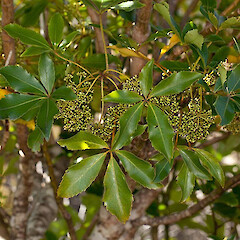Pseudopanax colensoi var. colensoi
Common name
mountain fivefinger, three finger
Synonyms
Panax colensoi Hook.f., Pseudopanax colensoi (Hook.f.) Philipson, Pseudopanax colensoi var. fiordensis Wardle, Neopanax colensoi (Hook.f.) Allan, Nothopanax (Hook.f.) Seem.
Family
Araliaceae
Flora category
Vascular – Native
Endemic taxon
Yes
Endemic genus
No
Endemic family
No
Structural class
Trees & Shrubs - Dicotyledons
Chromosome number
2n = 48
Current conservation status
The conservation status of all known New Zealand vascular plant taxa at the rank of species and below were reassessed in 2017 using the New Zealand Threat Classification System (NZTCS) – more information about this can be found on the NZTCS website. This report includes a statistical summary and brief notes on changes since 2012 and replaces all previous NZTCS lists for vascular plants.
Please note, threat classifications are often suggested by authors when publications fall between NZTCS assessment periods – an interim threat classification status has not been assessed by the NZTCS panel.
- Conservation status of New Zealand indigenous vascular plants, 2017 . 2018. Peter J. de Lange, Jeremy R. Rolfe, John W. Barkla, Shannel P. Courtney, Paul D. Champion, Leon R. Perrie, Sarah M. Beadel, Kerry A. Ford, Ilse Breitwieser, Ines Schönberger, Rowan Hindmarsh-Walls, Peter B. Heenan and Kate Ladley. Department of Conservation. Source: NZTCS and licensed by DOC for reuse under the Creative Commons Attribution 4.0 International licence.
2017 | Not Threatened
Previous conservation statuses
2012 | Not Threatened
2009 | Not Threatened
2004 | Not Threatened
Brief description
Small much-branched tree with 5 fleshy leaflets arranged fanwise on very short stems
Distribution
Central North Island and Coromandel Range south to Banks Peninsula (and possibly Dunedin) on South Island east coast. Apparently absent from South Island West Coast. Plants with sessile leaflets from the Fiordland-Stewart Island area are often referred to Pseudopanax colensoi var. fiordensis Wardle
Habitat
Montane to low alpine forest and scrub
Wetland plant indicator status rating
Information derived from the revised national wetland plant list prepared to assist councils in delineating and monitoring wetlands (Clarkson et al., 2021 Manaaki Whenua – Landcare Research Contract Report LC3975 for Hawke’s Bay Regional Council). The national plant list categorises plants by the extent to which they are found in wetlands and not ‘drylands’. The indicator status ratings are OBL (obligate wetland), FACW (facultative wetland), FAC (facultative), FACU (facultative upland), and UPL (obligate upland). If you have suggestions for the Wetland Indicator Status Rating, please contact: [Enable JavaScript to view protected content]
UPL: Obligate Upland
Rarely is a hydrophyte, almost always in uplands (non-wetlands).
Detailed description
Us. dioecious. Small multi-branched tree to 8 m tall, branchlets fleshy brittle. Leaves alternate, leaflets (3-)5(-7), palmate, subsessile or on short petiolules. Petioles 5-20 cm long, sheathing branchlet at base and with small erect stipule. Petiolules absent or short, of terminal leaflet to 0-5-10-(15) mm long, shorter on lateral leaflets, pale green, reddish at base. Leaflets narrow-ovate to broadly elliptic-oblong, cuneately narrowing to petiolule, thinly coriaceous, coarsely serrate-dentate in upper 2/3 - 3/4, acute to obtuse; midrib obvious above and below, lateral veins obscure; darker shiny green above; teminal lamina 5-17 x 2-11 cm, lateral leaflets decreasing in size. Inflorescence a terminal umbel; c. 8 primary rays (branchlets); 10-12 secondary rays; umbellules with 5-10 flowers in each. Calyx truncate or obscurely 5-toothed; flowers c. 5 mm diam.; petals 5, cream or greenish, ovate to triangular, acute; ovary 2-loculed, each containing 1 ovules; style branches 2. Fruit fleshy, 4-6 mm diam., style branches retained on an apical disc, dark purple when ripe. Seeds 2 per fruit, shallowly wrinkled, 2.9-4.3 mm long, rounded.
Similar taxa
Often confused with Pseudopanax arboreus, which also has 5 leaflets, from this species it can be distinguished by its shorter petiolules (leaflet stalk) and the base of the leaflet gradually narrowing to petiolule. The other varieties of Pseudopanax colensoi are distinguished their number of leaflets and distribution. The presence of a range of forms of probable hybrid arrangement at some sites can make identification difficult at times.
Flowering
October-March
Flower colours
Cream, Green
Fruiting
October-March
Etymology
pseudopanax: False cure
colensoi: Named after William Colenso (7 November 1811 - 10 February 1899) who was a Cornish Christian missionary to New Zealand, and also a printer, botanist, explorer and politician.
Notes on taxonomy
Pseudopanax colensoi var. fiordensis remains poorly understood. It may yet prove distinct from P. colensoi s.s. but further study is required. Recently, Frodin, D.G. and Govaerts, R (2003: World Checklist and Bibliography of Araliaceae, The Cromwell Press, European Union) reinstated Neopanax based on molecular and morphological evidence. In their work they did not provide combinations of the varieties recognised by Peter Wardle in N. colensoi (as P. colensoi). So as to avoid potential confusion we retain Neopanax colensoi in Pseudopanax until this issue is rectified.
Attribution
Description adapted from Wardle (1968), Allan (1961), Webb and Simpson (2001).
References and further reading
Allan, H.H. 1961. Flora of NZ, Vol. I. Government Printer, Wellington
Wardle, P. 1968. The taxonomy and distribution of the stipulate species of Pseudopanax in New Zealand. NZ J. Botany 6: 226-236
Webb, C.J. & Simpson, M.J.A. 2001. Seeds of NZ gymnosperms and dicotyledons. Manuka Press, Christchurch.










